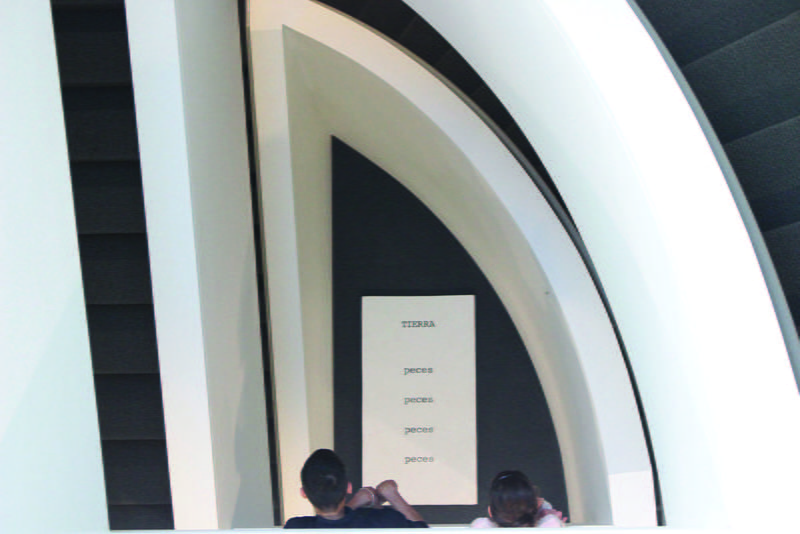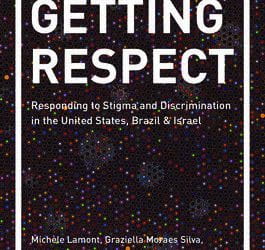Displacement Here, Displacement Now
“El Hambre de Mi Corazon”
In the Americas, and in Latin American and African-American poetic traditions in particular, there exists a practice of subverting notions of landscape as beauty in favor of more nuanced, historically informed, politically incisive renditions of the natural environment. Chilean poets and artists have been at the forefront of this politicized understanding of landscape, re-inscribing it in ways that make apparent the traces of conflict, violence and displacement so often erased from the more idealized, more pastoral renditions of nature. Few artists and writers have grappled more forcefully with this layered notion of landscape than Raúl Zurita, the acclaimed Chilean poet and last year’s Robert F. Kennedy Visiting Professor at Harvard.
Earlier this year, as spring turned to summer, I began to plan an exhibition of Zurita’s monumental poetry in collaboration with Marcela Ramos, program manager for ARTS@DRCLAS, and in conversation with the poet himself. It was he who suggested the evocative title of the exhibition: El Hambre de Corazón [Hunger of the Heart]. The exhibition, which opened in September, will remain on view until next spring. The poems selected for it are representative of Raúl Zurita’s larger body of work: poetry that broaches themes of pain, death, redemption and hope. His acts of writing of poetry in landscapes across the Americas—from the skies of New York (La vida nueva) to the desert of Atacama in Chile (Ni pena ni miedo)—is the departure point for this exhibition. In walls and nooks scattered through the offices of Harvard’s David Rockefeller Center for Latin American Studies (DRCLAS), we showcase the work of one of the most resonant voices in poetry from the Americas, temporarily placing it in the heart of a dynamic center of scholarship in a style and proportion that plays on the monumentality of Zurita’s landscape poems.
This layered notion of landscape is present from his very first works, epigrammatic and somberly visual poems printed on plaster slates resembling tombstones. These and other poems by Zurita use beautifully terse language to give voice to the experience of political oppression: voice to the people, the communities, and the natural environments that have succumbed to state violence. The poems featured in the exhibition, while evocative of displacement and forced disappearance during the military dictatorship in Chile, are written in a voice resonant enough to conjure other instances of state oppression, both past and present, distant and close to home.
The centerpiece of the exhibition is the wall of glass panels that rises from the entrance of the building where DRCLAS is located. This wall is visible from every floor in the building, and it anchors the atrium common to all three floors. A selection of poems from Zurita’s Canto a su amor desaparecido (1985), his grim tribute to the missing victims of state violence, is arranged strategically on the glass panels of this wall. The brief poems reproduced on these panels mimic file cards in their language and in their brevity. In print, on paper, they are graphically arranged so as to resemble niches. The rectangular shape of the glass panels in the exhibition echoes this resemblance, and once the poems were placed on them the wall took on the aspect of a monument or a columbarium, reproducing in real-life scale the architectural motif that organizes the layout of the poems in their original, printed-page platform.
“Peces,” included in the exhibition, is one of Zurita’s earliest poems first published in the critically celebrated single issue of the magazine Manuscritos. It was originally published as a photograph of a plaster slate where the poem itself was printed. For the exhibition, we commissioned a reproduction of this slate, rendered in a mix of plaster and cement to make it more durable. The poem is notable for its use of the blank spaces on the writing surface—in “Peces,” voids on the writing surface become meaningful elements of the signifying whole. Evocative of concrete poetry, masterful in its economy of verbal resources, “Peces” conveys the politically dense notion of landscape that would become a hallmark of Zurita’s general oeuvre. It is reproduced in this exhibition for the first time since its original publication in 1975.
Since the early 1980s, Zurita has been at the center of public poetry projects extraordinary in their ambition and reach. Each of these projects has aspired to turn three distinct features of the natural landscape—the sky, the desert, sea cliffs—into actual writing surfaces, surfaces where poetry can be written and read on a monumental scale. Video documentation and a large-scale photographic reproduction of one of these projects provide visitors to the exhibition with a glance of what each of these projects looks like, a feeling of the kind of intervention each makes in the landscapes on which they were inscribed.
For the first of these projects in 1982, five planes flew in formation over the skies of Queens, New York, spelling out in white smoke the words of Zurita’s verses. In 1981, a year before the writing in the skies took place, Zurita and others members of the Colectivo Acciones de Arte (C.A.D.A.) used light airplanes to drop thousands of leaflets over the city of Santiago (¡Ay sudamérica! 400.000 textos sobre Santiago), part of a series of cunningly defiant interventions in public space completed during the years of dictatorship in Chile.
Rigorous in its brevity, Zurita’s writing in the Atacama Desert boils down to a single verse, a micro-poem at once succinct and monumental. It reads ni pena ni miedo, “no shame no fear,” and strikes a defiant tone at a time of reckoning, in the years following the end of military dictatorship in Chile. In 1993, each of the words in this poem was bulldozed into the ground of the desert, over a length of about three kilometers. It is legible from above, from the sky, and can be viewed on Google Earth.
The last of Zurita’s monumental poetry projects, titled Verás, is yet to be realized. It consists of the projection of verses from a ship onto the walls of sea cliffs along the north coast of Chile. The projection is conceived to begin right before dusk, in such a way that the words projected onto the sea cliffs become brighter and clearer as the darkness of the night sets in. At dawn, these words made of light vanish gradually, erased completely by the light of the rising sun. For the exhibition, we used video documentation of sea cliffs surveyed by Zurita as possible sites for Verás and projected it partially on the ceiling of a conference room, in deference to the room’s functionality as an everyday working space and as a gesture that places the moving images of sea and sea water upwards, in the space where we usually look for the sky.
On Thursday, October 27, 2016, in the atrium where his poems are on view, Zurita read fragments of his Canto a su amor desaparecido to an audience of students, faculty, staff members and members of our community. As a way of activating the insistent, historical substance of Zurita’s poetry, a group of faculty and students performed a reading and a dance choreography based on a series of poems that, inspired by Zurita’s works, also seek to intervene a landscape, though one much closer to the geopolitical crossroads of our nation: the U.S.-Mexico border. These poems, titled the “Desert Survival Series” and written by the U.S.-based poet and scholar Amy Sara Carroll, are included in the Transborder Immigrant Tool, a design project conceived around the idea of distributing inexpensive, GPS-enabled cell phones among migrants planning to walk across the desert that straddles the United States and Mexico. The phones come loaded with poems, a key feature of their design. They are also outfitted with locative software that can guide migrants to water posts, rescue sites, and other resources critical for survival in the trek across the desert. As mapped by the “Desert Survival Series” poems, the Sonoran desert is restaged, or rather, re-screened, from appearing as the entryway of furtive migrants to being the site of ghastly, excruciating deaths numbering in the thousands.
The double reading of poetry on October 27, staged on site at the exhibition, revealed—if only for a moment—the desert in particular and landscapes at large in all their terrible contradiction: as places of magnificent beauty and scenes of countless deaths, sites of unspeakable violence. For a moment, nourished by the words of the greatest living poet in the Americas, those of us present at the reading felt moved and strong, bolstered enough to witness together as one and the same thing all the beauty and all the pain of the environments that surround us. For a moment, it felt as if we had the power to resist the erasure of pain and violence that sustains the most necessary of illusions: the dream of living in a land of liberty, the dream of being in a free world. It was a moment to be cherished, especially here, especially now, in times when the work of remembrance, when the work of resisting the “privilege of unknowing,” is most called for.
In a world so relentlessly defined by utilitarian reasoning, by expedient thinking, by prose language and by vicious speech, poetry is decisively out of place. Displacement, though, is what accounts for poetry’s extraordinary capacity for meaning. Relieved of the duties of routine communication, released from the onerous burden of serving as utilitarian vehicle of messages, poetry is free to soar and rove, revealing sublime sights (sights of tremendous beauty, sights of great terror) seldom, if ever, accessible to prosaic language. Raúl Zurita taps into this freedom in poetic language, this liberty from the constraints of language that is only useful. He does so to reveal landscapes of affect and love so violently effaced from the historical record makes his poetry all the more compelling.
Winter 2017, Volume XVI, Number 2
Sergio Delgado Moya is Associate Professor of Romance Languages and Literatures at Harvard University. He is the author of Delirious Consumption: Aesthetics and Consumer Capitalism in Mexico and Brazil, 1950s-70s, forthcoming with the University of Texas Press.
Related Articles
Colombia’s Other Displacements
Of course, I knew about Colombia’s sad statistics on displacement, with the highest numbers in Latin America and vying with those of war-torn countries like Sudan and…
Getting Respect
When I first arrived in Brazil in the 1980s, I quickly learned that race in Brazil was not important there. The country that once had by far the largest slave population in the…
Ana Tijoux’s Radical Crossing of Borders
This summer, I was an intern in Santiago’s Museum of Memory and Human Rights, the museum dedicated to the victims of Pinochet’s dictatorship. Since I was in Chile…





